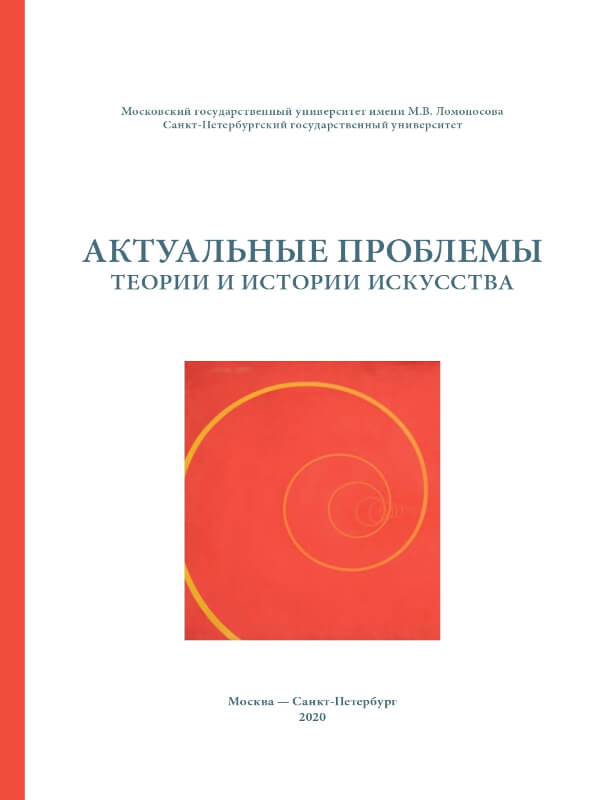“Space, Mass, Surface in Architecture”: Conceptualization of Spatial Categories and a Building as a Border in Architectural Thought and Practice of the Soviet Constructivism
DOI:
https://doi.org/10.18688/aa200-3-41Keywords:
Soviet architecture, Constructivism, architectural education, architectural propaedeutics, architectural theory, space in architectureAbstract
In the post-revolutionary years Soviet architects developed new system of professional thought based on the conceptualization of space (and also on the fashion on psychology). This “spatial turn” was common at the beginning of the Modern movement. The very model of the architects’ activity and their selfperception changed dramatically: instead of shaping volumes they started “setting the borders” and “organizing” space with surfaces. New focus in Constructivist architecture was reinforced with ideas of expansion and space exploration (popular since the late 19th century) and the “cosmic” vision of Russian Avant-garde art.
The social concern of professional community and the vision of architecture as a field of social interactions contributed to this changing perspective and resulted in new plans and functional arrangement of buildings (e.g. commune houses) as well as new town-planning concepts (linear city, parabolic city). The new grade of flexibility achieved using concrete framework and curtain walls changed the architects’ attitudes towards both internal structure and the surface of building.
Soviet architects of the 1920s managed to establish new spatial concept as the pedagogical basis of architectural school, starting from Nikolay Ladovsky’s course “Space” at VKhUTEMAS. This system, converted into textbooks on “Volumetric-Spatial Composition,” survived in the period of Stalinist anti-Modernist reaction. Even today it lies in foundation of Russian architectural school. The article examines the concept, itssources, establishment, and the reasons for its persistence.
References
Bass V. The Discourse of Form as the Last Refuge of the Soviet Architect. Novoe literaturnoe obozrenie (New Literary Observer), 2016, no. 1 (137), pp. 16–38 (in Russian).
Beker R. R. Architecture and Society. Trudy IV s”ezda russkikh zodchikh (Proceedings of the 4th Congress of Russian Architects). St. Petersburg, Gosudarstvennaia tipografiia Publ. 1911, pp. 584–590 (in Russian).
Cooke C. ‘Form is a Function X’: The Development of the Constructivist Architect’s Design Method. Russian Avant-garde. Art and Architecture. Architectural Design Profile 47, 1983, pp. 34–49.
Cooke C. Russian Avant-garde Theories of Art, Architecture and the City. London, Academy Editions Publ., 1995. 208 p.
Frankl P. Principles of Architectural History: The Four Phases of Architectural History, 1420–1900. Transl. by J. F. O’Gorman. Boston, Mass., MIT Press Publ., 1982. 239 p.
Gabrichevskii A. G. Space and Mass in Architecture (1923). Morfologiia iskusstva (The Morphology of Art). Moscow, Agraf Publ., 2002, pp. 430–447 (in Russian).
Ginzburg M. Ia. Ritm v arkhitekture (Rhythm in Architecture). Moscow, Sredi kollektsionerov Publ., 1923. 116 p. (in Russian).
Ginzburg M. Ia. Stil’ i ėpokha (The Style and the Epoch). Moscow, Gosudarstvennoe izdatel’stvo Publ., 1924. 238 p. (in Russian).
Ginzburg M. Ia. The Functional Method and Form. Sovremennaia arkhitektura (Contemporary Architecture), 1926, no. 4, pp. 89–92 (in Russian).
Ginzburg M. Ia. Results and Prospects. Sovremennaia arkhitektura (Contemporary Architecture), 1927, no. 4–5, pp. 112–118 (in Russian).
Ginzburg M. Ia. Constructivism as a Method of Laboratory and Pedagogical Work. Sovremennaia arkhitektura (Contemporary Architecture), 1927, no. 6, pp. 160–166 (in Russian).
Ginzburg M. Ia. Zhilishche (Dwelling). Moscow, Gosstroiizdat Publ., 1934. 190 p.
Grois B. Stil’ Stalin. Utopiia i obmen (Stalin Style. Utopia and Exchange). Moscow, Znak Publ., 1993. 373 p. (in Russian).
Krinsky V. F.; Lamtsov I. V.; Turkus M. A. Elementy arkhitekturno-prostranstvennoi kompozitsii (Elements of Architectural and Spatial Composition). Moscow; Leningrad, Gosstroiizdat Publ. 1934. 172 p. (in Russian).
Ladovskii N. A. On the Role of Space in Architecture and on the Nature of the Synthesis of Architecture, Sculpture, and Painting. 1920. Mastera sovetskoi arkhitektury ob arkhitekture (The Masters of Soviet Architecture on Architecture), vol. 1. Moscow, Iskusstvo Publ., 1975, p. 344 (in Russian).
Lamtsov I. V.; Turkus M. A. Ėlementy arkhitekturnoi kompozitsii (Elements of Architectural Composition). Moscow, Leningrad, GONTI Publ., 1938. 168 p. (in Russian).
Ledoux C.-N. L’Architecture consideree sous le rapport de l’art, des moeurs et de la legislation: tome premier. Paris, De l’imprimerie de H. L. Perronneau, 1804. 240 p. (in French).
Lukomskii G. K. Sovremennyi Peterburg. Petrograd, Svobodnoe Iskusstvo Publ., 1917. 94 p. (in Russian).
Nekrasov A. I. The Given and the Conceived in the Spatial Arts in Terms of Perception of Space. Trudy Sektsii iskusstvoznaniia Instituta arkheologii i iskusstvoznaniia RANION (Proceedings of the Section of Art Studies of the Institute of Archeology and Art Studies RANION), 1928, no. 3, pp. 3–17 (in Russian).
Orel E. Otrazhenie psihologicheskoi nauki v traditsii prepodavaniia arkhitektury v SSSR1920-kh godov (Reflection of the Psychological Science in Architectural Education in the USSR in the 1920s), MA Thesis. St. Petersburg, European University at St. Petersburg, Department of Art History Publ., 2017. 81 p. (in Russian).
Papernyi V. Kul’tura Dva (Culture Two). Moscow, Novoe literaturnoe obozrenie Publ., 1996. 383 p. (in Russian).
Payne A. From Ornament to Object: Genealogies of Architectural Modernism. New Haven, Yale University Press Publ., 2012. 360 p.
Schwarzer M. W. The Emergence of Architectural Space: August Schmarsow’s Theory of “Raumgestaltung”. Assemblage, 1991, no. 15, pp. 48–61.
Tsapenko M. P. O realisticheskikh osnovakh sovetskoi arkhitektury (On the Realist Grounds of the Soviet Architecture). Moscow, Gosstroiizdat Publ., 1952. 395 p. (in Russian).
Viollet-le-Duc E. E. Discourses on Architecture. Boston, J. R. Osgood and Co Publ., 1875. 517 p.
Vlasov A. Creative Work Report. Arkhitektura SSSR (Architecture of the USSR), 1935, no. 4, pp. 55–58 (in Russian).
Vronskaya A. The Productive Unconscious: Architecture, Experimental Psychology and the Techniques of Subjectivity in Soviet Russia, 1919–1935, Ph. D. Thesis. Cambridge MA, Massachusetts Institute of Technology, 2014. 405 p.
Vsesoiuznoe soveshchanie po stroitel’stvu. Sokrashchennyi steno-graficheskii otchet (Abridged Transcript of the All-Union Building Congress). Moscow, Gosstroiizdat Publ., 1955. 432 p. (in Russian).
Zucker P. The Paradox of Architectural Theories at the Beginning of the “Modern Movement”. Journal of the Society of Architectural Historians, 1951, vol. 10, no. 3, pp. 8–14.


